#math for young learners
Explore tagged Tumblr posts
Text
🎉 Alice's Ultimate Guide to Mastering (and Maybe Even Loving) Long Division! 🎉
By Alice Hey everyone! It’s me, Alice, your favorite adventurer, snack enthusiast, and math-avoider turned math-explorer! 😱 Big Sister Ariel has written the most amazing and smartest paper EVER about long division, and guess what? I actually understand it! (Shh… don’t tell her I said that! 😆) You wouldn’t believe how exciting it was to dive into numbers and see how everything fit together. Long…
#Alice&039;s blog#arithmetic for kids#Creative Math Lessons#Division for Kids#division made easy#education#educational fun#Engaging Math Lessons#fractions#fun math for kids#fun math worksheets#fun with numbers#hands-on math#homeschool math#interactive learning#kid-friendly math#kids math activities#Learning Math with Alice#learning through play#Long Division#math#math adventures#math challenges#Math Coloring Page#math for elementary students#math for young learners#Math Learning Games#math puzzles#math storytelling#Math Superheroes
0 notes
Text
#benefits of learning math early#early math skills for kids#online math classes for young learners#1-on-1 math tutoring for kids#early childhood math education#best age to start math tutoring#foundational math for kids#how math helps kids succeed#early math and brain development#tutree
0 notes
Video
youtube
Pumpkin Subtraction| Thanksgiving Math Edition| How to Subtraction for K...
#youtube#**YouTube Description:** Get ready for a pumpkin-packed math adventure with our *Pumpkin Subtraction* video! 🎃🍂 Perfect for young learner
0 notes
Text
One of my favourite things about Jason is how much of a fast learner he is- sure, maybe he’s not some high school genius like Tim and doesn’t have the same innate athletic ability that dick has, but he can learn pretty much anything he sets his mind to.
As a young kid, he learned the resourcefulness and sneakiness needed to survive in crime alley. Learned how to steal what he needed to get by, including the rims of the batmobile. After Bruce adopts him, he learns everything he needs to be Robin- sure, he’s not as much of a dramatic showman as dick, but to the untrained eye he can appear as just as skilled. Enough to handle himself in a fight, enough to jump out of the way. He learns to listen to orders from Batman, something that would not have been natural for him as a child to do so instinctually. He learns to work well with others, even though he’s allowed to do so so rarely.
So much of his life is him having to suddenly adjust to new things all the time. The streets, being robin, the few times he fought with any hero’s aside from batman. Then he uses those resources he got from being robin to go off to ETHIOPIA and sure, he dies. But then he’s alive again and still- this shows just how much of a fast learner he is. His mind is reduced down to pure instinct, and he’s still able to survive. Steal to eat, protect himself to survive. He performs moves no other child his age would ever be able to perform, especially not with the severe brain damage he’s suffering. Because they’re INSTINCT to him. Because those moves and that need for survival are so deeply engrained into his body that they’re muscle memory for him, that he’s able to act and react literally when he’s not even able to think for himself at all.
And then the Lazarus pit, and his learning only continues. He doesn’t do just the bare minimum either. With each teacher he gains and eventually kills, he gains more skills than any one person could ever hope to collect in their brain. He practices them and he keeps them and I’m sure they become just as much instinctual knowledge as anything else. He masters things he should be scared of as a child who died how he did- he uses bombs so casually, keeping them in his own helmets, as if it wasn’t a bomb that killed him.
That’s not the point of this post but just- he’s so smart. He’s not some scientist or math wiz. He’s a kid who loves books and collecting information that he can use in the future. That can help him with his cause. And that information he collects has to do with other people, too- from the first time he meets Roy he’s able to see when he’s uncomfortable and hiding something. When he reveals himself to bruce, he knows he won’t trust it right away and is ready to provide his own dna as proof. He understands tim and his insecurities in a way most of the others in their family don’t, because they SHARE them. He notices Damian’s weak points when they fights and makes sure to USE them, to show damian a lesson that there’s still things he needs to learn.
I don’t know, I just don’t think people talk about how smart Jason is enough. How brilliant he is at collecting information and keeping it exactly where he needs it for future use. That boy might be the smartest person in all of gotham.
#he still makes dumb choices sometimes bc he is also the king of Big Feelings but shhh#like you go king project your feelings onto your siblings even if you’re not fully right about them#jason todd#batfam#batman#batfamily#damian wayne#dc comics#red hood#bruce wayne#tim drake#rambles
63 notes
·
View notes
Text
We saw how Vander took care of Vi and Powder it got me thinking. What did silco do for these girls? Vander provided security, food and a caregiving to them both.
Maybe silco was busy figuring out Zaun yes, but I like the Idea of him teaching them intellectual skills — Vander taught them street smarts, Silco taught them Book smarts. Such as;
Reading, writing, some basic math, and saw how powder was smarter then she seemed to be able to make things, and maybe at her young age, she was a quicker learner? That's why Silco felt like he could trust her in his gang. She was a quick learner.
And had a rough idea on where her smarts sat, seeing how he was possibly the last person who taught her before he left after the bridge with Vander??
Just a thought!!
27 notes
·
View notes
Text

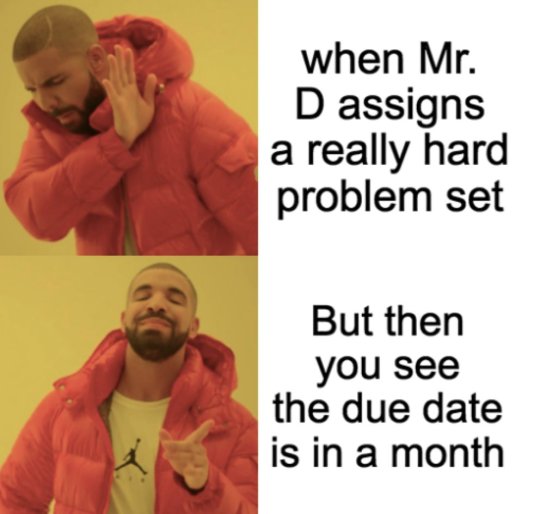






HS Math Memes
Benjamin Dickman had his learners read the lit review (chap 2) of a thesis about math memes and then make their own. Posted here on Twitter, though he's mostly on Bluesky these days.
More from the thesis:



From the conclusion:
"Overall, the portrayal of not only mathematics but also the people who excel at it in popular culture, specifically memes, affects students’ mathematical identities and may prevent young students from finding interest in the field and/or affect their participation in mathematics (Wood, 2013). As stated by Nasir (2002) the fluidity of mathematics identity—that one’s mathematics identity depends on contextual experience—was witnessed throughout this study. And it is important to note that the process is not a socially or culturally neutral process (Jackson, 2009). Latterell and Wilson (2004) summed it up by stating, “Students shut mathematical doors early in life and it is difficult to open a mathematical door later in life” (p. 12)." Mathematics in Popular Culture: An Analysis of Mathematical Internet Memes, Benoit, Gregory, 2018, Columbia Teachers College
15 notes
·
View notes
Text
Universal Pictures UK has partnered with Into Film to create a career learning programme designed to help young people fly into their futures with confidence. It aim's to demystify screen industry careers by spotlighting the roles of trainees who worked to bring #WickedMovie to the big screen.
“To celebrate the release of Wicked, only in cinemas from November 22, we’ve created a careers-focused learning programme to empower young people to unlock their unique powers. Wicked Futures: Careers in Film is a free learning sequence for students aged 12-18. Activities demystify careers in the screen industries by profiling trainees who helped bring Wicked to the big screen. Supported by objectives from English/literacy, maths/STEM and PSHE, learners will be inspired by the diversity of the film production roles showcased, and the power of their own skills, experiences and qualifications. The sky’s the limit!”
Teachers and Parents from the UK can also submit their students and children to their contest before December 20th: “Enter social media maestros to our competition for a chance to win a content creation kit and Wicked screening. Screen industry careers don’t only exist on set! Our Marketing Wiz competition focuses on how films reach audiences, challenging students to apply their knowledge of social media by creating an exciting promotional post to help Wicked soar in cinemas. Enter your students ahead of the closing date of Friday 20 December. Terms and conditions apply. The creator of the most magical post will win an iPad and Apple Pencil Pro. The winner’s class will receive a cinema screening of Wicked, and two runners up will win Wicked merchandise bundles.”
More information n the link below:
#wicked#wicked movie#ariana grande#glinda upland#elphaba thropp#dailygrande#cynthia erivo#gelphie#galinda upland#wicked the musical#film#cinema#universal pictures#into film#contest
13 notes
·
View notes
Text
Post- family abandonment HCs
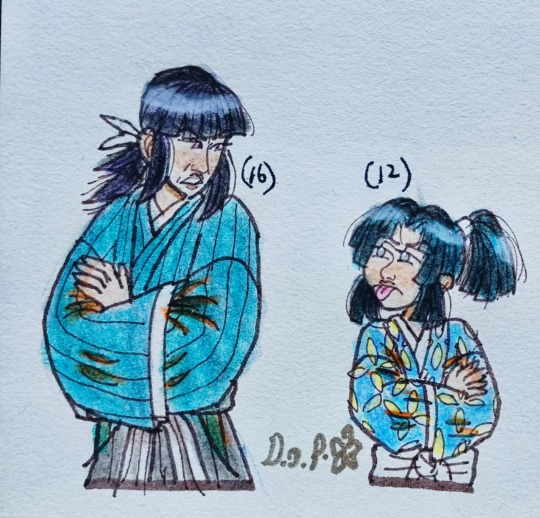
After Michikatsu unexpectedly abandoned his family, they're immediately left to the wolves. No one has heard from him or could find his whereabouts. They didn't even know that Michikatsu would eventually become a demon. Yoriichi never knew that Michikatsu had a family.
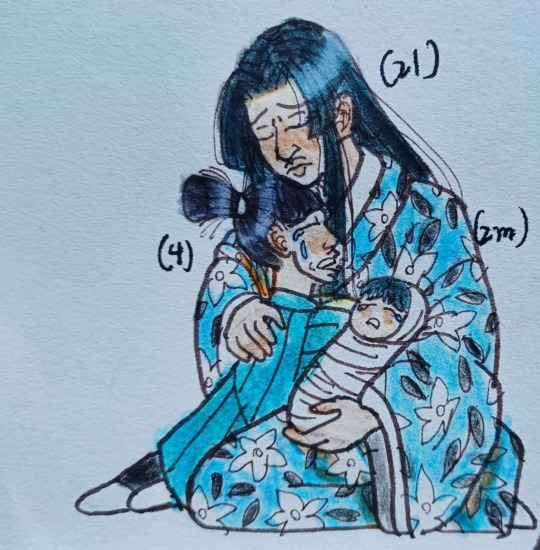
Hanami & her sons tried to seek refuge in her parent's house since her in-laws are obviously out of the question. However, a fight between her & her parents instigated. Her parents blamed her for being a:"failed wife," even saying that she must've done something insidious to make Michikatsu abandon her. They didn't appreciate the fact that they lost connection to such a prestigious, powerful family. They also went as far to say that Hanami is a disgrace who brought humiliation upon their family name. The argument ended with Hanami being disowned by her family. After that day, Hanami & her sons never sat foot near the residence again.
With as much money & belongings she could bring on her back, Hanami & her sons moved into a small village far from her home village due to gossip. As a noblewoman, it was quite difficult for a while to be accustomed to a peasant. To support her sons, she found a job as a seamstress at a kimono shop.
Life as a single mother is a life hardly any woman ever dreamed of. Being the sole provider & protector, no friends or family, stigma surrounding single parenthood, Hanami only kept on living for the sake of her sons. She's a lot more isolated than before, afraid to form deep connections with others in fear that her past will be brought to light. She never remarried, especially knowing that no man wants to be a stepfather.
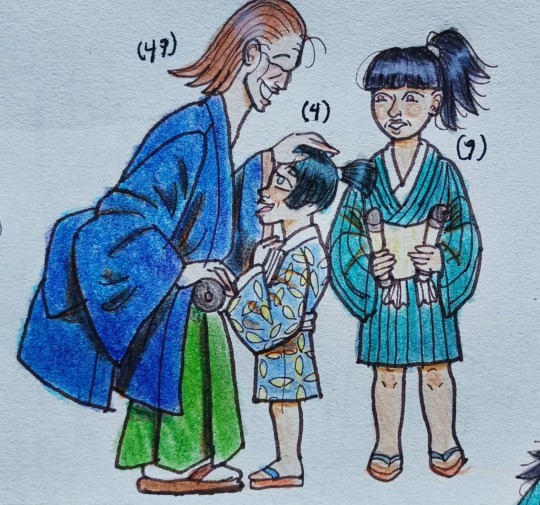
Genji from a young age is more enthusiastic with his mother's stories than Hiroshi is. When he was 4, while out shopping in the market with Hanami, he noticed that a scholar accidentally dropped one of his scrolls. He recognized the title of the scroll as one of the stories his mother tells him about. Curious that a commoner child somehow knows how to read, the scholar decided to take in Genji & Hiroshi as his students.
Genji is a fast learner & can easily memorize information. He quickly mastered Kanji brushstrokes, can solve math problems in a few seconds & quickly went several levels ahead his reading level. In less than six months, he's already learning advanced material with ease. In modern day, he'll be given the term "gifted child".
At first, Hiroshi was impressed that his little brother is intelligent for his age. However, the pride for his brother soon turned into jealousy when he noticed that his teacher praises Genji more than him. Genji will be passing tests with flying colors, is friends with all of their classmates and is overall seen with more potential. No matter what Hiroshi does, he could never keep up with Genji.
To further have his jealousy grew, he starts to notice his mother being more impressed with Genji's achievements than his. For a while, Hiroshi tried to write his own stories in hopes of impressing his mother. Of course, their mother would enjoy reading Genji's stories over his due to superior writing quality.
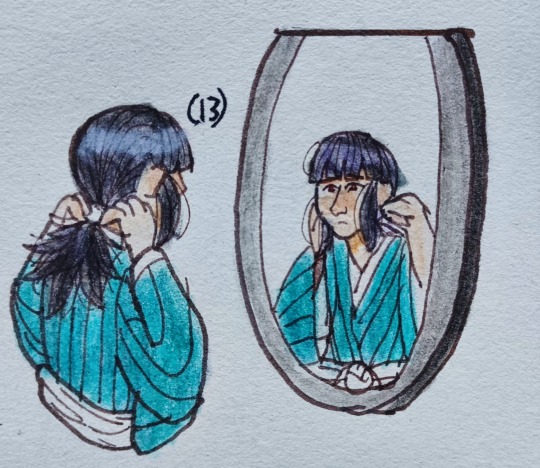
Hiroshi's resentment for his father grew within age as he started looking more similar to him. At first, as a young child, he wishes for his father to come back home, not yet understanding that father will never come back. Over time, he gave up his dream of becoming a samurai since he wanted nothing to do with his father. After all, he notices that his mother subconsciously starts to struggle looking at him for long periods of time. Starting at 13, he wore his hair in a low ponytail in hopes of looking less alike to his father.
Meanwhile, Genji appears more similar to his mother as he gets older. Not only that, he also inherited her once long gone passion for writing & storytelling. Unknowingly, each passing day, Hanami starts to live out her dreams & ambitions through Genji. At age 12, Genji published his first novel. It was so successful to the point where the family gets to upgrade their home & afford more than two sets of clothes.
Genji isn't just favored in his family & school-he's also favored in his village. Many enthusiastic to see him as he passes by, frequently has friends over & going to friends' homes & being pined after by many girls his age.
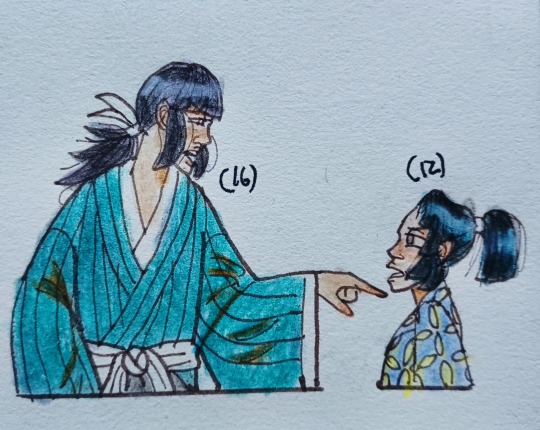
The success of Genji's debut novel started a first major argument between the brothers. Hiroshi argued that Genji is always better than him & Genji argued that Hiroshi stopped being happy for his achievements. The argument ended with Hanami siding with Genji & forcing Hiroshi to apologize for starting the argument.
After that argument, a rift is forming between the brothers. They became less close than they were as children and spent less time together.
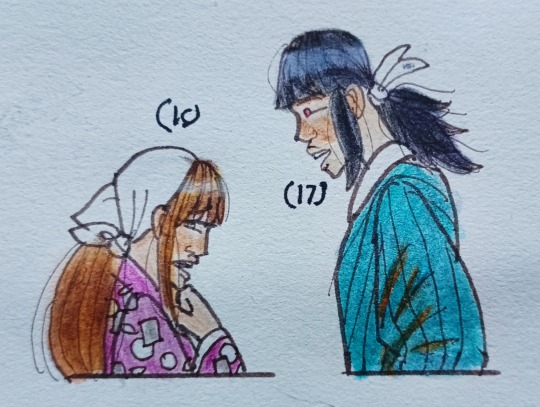
When Hiroshi was 16, he had a crush on Izumi, the daughter of a restaurant owner. He stops by the restaurant as much as he can afford to, stays there for long periods of time and overall enjoyed hanging out with Izumi. He feels comforted by her cheery nature, enjoys all of her jokes and appreciates her never comparing him to Genji. On his 17th birthday, he confessed his crush to Izumi. At first, the girl refused to tell him how she feels about him. By immense pressure from Hiroshi, she confessed that she only sees him as a friend. To make matters worse for Hiroshi, Izumi also confessed to him that a week before his brithday,she already confessed her feelings to Genji & that he reciprocated. She tried keeping relationship with Genji a secret in hopes to not ruin Hiroshi's birthday. This is the last straw for Hiroshi.
The 2nd & last argument between the brothers started the day after Hiroshi's 17th birthday. All of the jealousy & fury Hiroshi had for Genji came out at an unstoppable force. Genji is fed up with having a brother who always envied towards him. In the heat of the moment, Hiroshi told Genji that he always despised him from the start & he wished he's always the only child. Hanami ended the argument by having Hiroshi be confined to his room before consoling Genji. Hiroshi sobbed alone in his room with no one coming to comfort him.
Hiroshi is sick of always being 2nd place to his much more brilliant, charming, witty younger brother. He quickly devised a plan to just making a new life for himself away from his family & village. He packed up as much items he could carry & then wrote a note addressed to his mother & Genji. He left the note on his futon before leaving through his bedroom window in the middle of the night.
Hanami couldn't sleep well from the recent argument between her sons. While contemplating in her thoughts, she realized how much of an awful mother she is for having favoritism. Before she falls asleep, she planned to apologize to Hiroshi first in the morning for all of her mistakes as a mother.
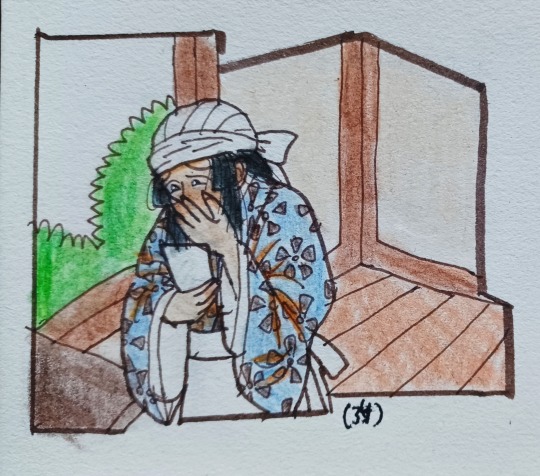
Unfortunately, that argument is the last time Hanami ever saw her eldest son. The next morning, she couldn't find Hiroshi in his bedroom. Instead, she found the note he left on his futon. Upon reading it, she broke down in tears for not noticing her mistakes sooner. When Genji reads the same note that morning, he feels guilty for occasionally bragging about his achievements & for sometimes undermining his brother's.
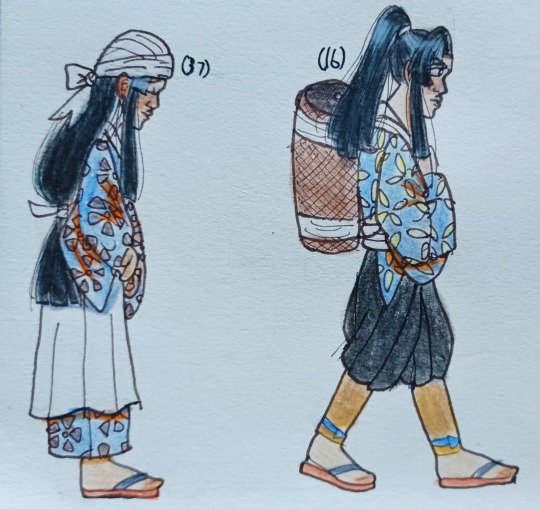
When Genji turned 16, he revealed to Hanami that he made a plan within 2 years to try finding Hiroshi. Hanami tried to stop Genji from his journey, but eventually lets him go out of defeat. Sadly, that'll be the final time Hanami saw her remaining family. Unfortunately, 3 week's later, Genji's body was found in the middle of a forest by a demon slayer. He confirmed that Genji was murdered by a demon. Hanami got the news a week later & spends the rest of her days alone until 62 never forgiving herself. The fate of Hiroshi is unknown since no one could find him. Unbeknownst to him & even Kokushibo, he'll eventually be the 100x(+?) great-grandfather to the Tokito twins...
29 notes
·
View notes
Text
The Role of Abacus in Developing Mathematical Confidence
How the Abacus Boosts Mathematical Confidence
The abacus, a tool with origins tracing back thousands of years, remains an invaluable instrument in modern education. Far from being obsolete, this simple yet powerful device has proven to be a cornerstone in developing mathematical confidence, especially among young learners.
Building a Strong Foundation
At its core, the abacus transforms abstract mathematical concepts into tangible, visual, and tactile experiences. For many students, numbers and calculations can feel overwhelming, especially when introduced in traditional formats like equations or symbols. The abacus bridges this gap by offering a hands-on approach. Moving beads to represent numbers allows learners to physically interact with math, making concepts like addition, subtraction, multiplication, and division more accessible and less intimidating.
Improving Concentration and Focus
Using the abacus requires concentration and precision. As students manipulate the beads, they learn to focus on each step of the calculation, developing discipline and patience. This repeated practice not only sharpens their mental math skills but also instills a sense of accomplishment with every correct answer. Over time, these small wins boost their confidence in handling increasingly complex mathematical problems.
Enhancing Memory and Visualization Skills
One of the unique benefits of the abacus is its ability to train the brain to perform mental calculations. As students become proficient, they often transition from the physical abacus to an imaginary one, visualizing bead movements in their minds. This practice enhances memory retention, spatial awareness, and cognitive flexibility—skills that extend beyond math to other areas of learning and problem-solving.
Breaking the Fear of Math
Math anxiety is a common barrier for many students. The abacus, with its playful and interactive nature, removes the fear associated with numbers. It reframes math as a game of patterns and strategies rather than a rigid subject. This shift in perspective transforms reluctant learners into enthusiastic participants, empowering them to approach math with curiosity and confidence.
Lifelong Benefits
The skills developed through abacus training—focus, visualization, memory, and problem-solving—are not limited to mathematics. They lay the groundwork for analytical thinking and decision-making in everyday life. Whether a student pursues a career in science, business, or the arts, the confidence gained through mastering the abacus becomes a lifelong asset.
In conclusion, the abacus is much more than an ancient calculating tool; it is a gateway to building mathematical confidence. By simplifying complex concepts, fostering focus, and encouraging mental agility, the abacus empowers learners to conquer math with self-assurance and enthusiasm. In a world increasingly reliant on technology, the abacus reminds us that sometimes, the simplest tools can make the most profound impact.
11 notes
·
View notes
Text
Latin-101!

A little story for context under the cut!
"Mom, please tell Dad that I don't need a tutor. I can learn Latin, history, and math all by myself. After all, I learned botany, playing chess, and charting stars in the tower on my own!" Rapunzel insisted to Arianna as Frederic proposed hiring a home tutor for her.
"Sweetie, I know you're really smart, but it will be better if you study under the care of a professional. Besides, it won't take long for you to finish the courses since you are a very fast learner," Arianna assured her only daughter.
"Aw..." Rapunzel pouted.
***
"You have class this afternoon? But it's supposed to be our date today, Blondie!" Eugene expressed his frustration.
"I know, but there's nothing I can do. Mr. Muller is very strict; I can't just cancel his class. He taught my dad as well. Dad really respects him, and I can't let him down," Rapunzel sighed disappointedly.
***
Mr. Muller started teaching Rapunzel history, geography, math, law, and Latin a couple of weeks ago. Rapunzel had to take two tests on history and math already. She can't catch a break lately due to her tight schedule. That old man is always putting Rapunzel under huge pressure by giving her random assignments and tests.
"This week, you're going to sit for a Latin exam, young lady," Mr. Muller declared as soon as he entered the classroom.
Rapunzel almost cried. She had plenty of plans for this week because Mr. Muller said if she got good marks, he'd grant her a leave as a reward.
"But, Mr. Muller, I got an A on both subjects!" She reminded her teacher.
"So?" Mr. Muller frowned.
"You said you would grant me a leave if I got good marks."
"Define good marks first. You should have gotten an A+. I made the questions ridiculously easy for you, and still, you failed to get 90 percent!"
Rapunzel sighed.
"Anyway, today we'll learn some syntax. Uh... open your book to page 48."
***
"Did you hear me, young lady?" Rapunzel woke up suddenly as she heard Mr. Muller's monotonous voice. She had almost fallen asleep because of the boring lecture.
"Yeah, I did!" She replied while trying to suppress a yawn.
As Mr. Muller continued lecturing, she started drawing a sketch of the teacher.
"Hmm... his hair reminds me of a rat's ear! Ooh, and look at that nose, as red as a ripe apple! The bald part of his head reflecting the ceiling like a brand new mirror! His fat belly is trying hard to tear apart his shirt..."
"What are you drawing over there, young lady?" Rapunzel became aware as Mr. Muller shouted. Her heart skipped a beat.
"N-nothing," Rapunzel stammered as she tried to hide the drawing.
"Hand it over to me," the old professor demanded.
"I... I... I..." Rapunzel continued stammering.
"Give it to me!"
Rapunzel handed over the drawing finally. "Please, don't tell Dad!" Rapunzel pleaded.
Mr. Muller looked at the drawing closely, getting his eyes close to the paper, and then he peeked over his glasses and observed the drawing after taking the piece of paper far from his eyes.
"Hmm," he muttered.
Rapunzel was trembling in fear.
"Hmm... it's actually... it's actually pretty good! I like it! You certainly have a knack for it, don't you?" he asked Rapunzel, his eyes full of appreciation now.
"You liked it?" Rapunzel couldn't believe her ears.
"Yeah, I'm keeping this. You should continue making art; you're gifted."
Rapunzel's smile almost reached her ears.
"But NOT IN THE CLASS, hear? For the last time, I'm saying this... NOT IN THE CLASS." Mr. Muller roared like a crazy tiger.
Rapunzel listened to him silently while noticing embarrassedly that Eugene and Pascal had arrived at the door at her teacher's rising voice.
***
The End!
#Rapunzel#Eugene Fitzherbert#Pascal#Tangled#Tangled the Series#Rapunzel's Tangled Adventure#art#artists on tumblr#digital art#ibispaint x#my art#fan art#illustration#fanfiction
11 notes
·
View notes
Text
Ghibli Geometry Homework
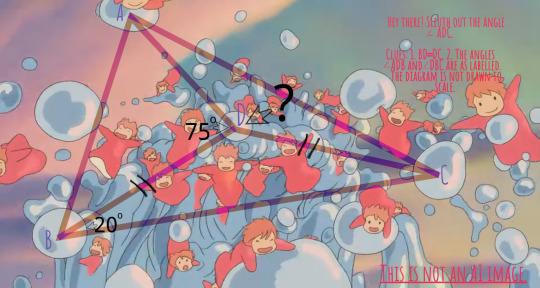
Merch Bubble: A petition for Studio Ghibli to best OpenAI by channeling the 2025 trend of cheery citrus-juiced images into an endeavor with more lasting impact — revamping the image of math and captivating young learners through geometry problem sets jazzed up with visuals and story contexts from its films.
Picture the following in their relevant aesthetic backdrops:
Estimate the height Spirited Away's Chihiro successfully descends despite her fear as she speeds down a rickety stairway section with 20 horizontal steps. Each gap between the steps is 5 units in slope and 4 units in width.
Spirited Away's No-Face tries out a circular mask 3 units in radius. Its holes for his eyes are 0.3 units in radius. How many times larger in area is his fake face compared to his fake eyes?
He next tries out a fancy circular mask which outline circumscribes tightly-packed, non-overlapping circles each 0.3 units in radius. The circles are made up of k rings of six circles surrounding one circle. Two of those hexagonally packed circles form holes for his eyes. How many times larger in area is his fake face compared to his fake eyes?
Witch Kiki in Kiki's Delivery Service is on a 10-unit long broomstick tilted at 45 degrees as she takes freshly baked cinnamon rolls to a customer. As she passes by a tall structure, she notices its tip is labeled 10, 000 units. The rolls are in a 2-unit long satchel hanging halfway on the broom. Since the temperature of the air affects how fast pastries go stale, she wonders: How far are the rolls from the ground?
A bunch of kids are squeezing onto the ginormous, fluffy tummy of the furry creature Totoro from My Neighbor Totoro. Predict how many kids can stay on the tummy given the relevant simplifications, assumptions and information. (You already got the drift.)
Make no mistake. There's much virtue in the uncluttered designs of typical math worksheets: faster concept rendering, faster information perception, lower workloads, lower technical requirements and lower production costs. One might sum them up as higher time, resource and cost efficiencies. Add to those pros a potential cultivation of academic asceticism on the learners' part. That would be efficiency as well, in the sense that we meet two student developmental goals (math and discipline) in one shot.
In eyeing these efficiencies, however, teachers and allied industry players may be neglecting their numerator terms, most of which concern learner progress. That is ironically where pure quantitative logic breaks down. We are all emotional creatures. That is all the more so, all things equal, in young people whose brains are still underdeveloped. Looking around, we can see many school leavers who have not matured in time to take full advantage of educational resources temporally and financially accessible only in early life stages. Nor have they met adult figures sufficiently skilled in the elusive art of mathematical motivation. By the time such school leavers gain an appetite for delayed gratification, austere thinking as well as for the inherent beauty in quantitative subjects, adulthood commitments and sociocultural barriers like ageist biases often deter or delay their reentry into the educational system, threatening their scholastic journey and any STEM career trajectory. There is therefore a case to be made for deep yet down-to-earth arts-based engagement of apathetic young learners, many of whom struggle to perceive the relevance of abstract fields like geometry and find math problems in general mundane, through instructor-independent means. The emotional resonance and relatability of Studio Ghibli's works — evinced through their box office successes and the controversial generative art trend applying a warm, effusive and rustic Ghibli style to personal images — would make them powerful helpmates in battles against math hate viruses, which feel as far-reaching as influenza bugs.
Even engagement of kids who will become non-STEM high-fliers can make a huge difference. Ever heard of the phrase "The medium is the message"? Our communication approaches communicate values and signals beyond what our content says. In denying all exuberant expressions of emotion and wonder a place in mathematical materials, even in the face of learners impaired by hopelessness despite their best efforts, adults are reinforcing perceptions of mathematics experts as inflexible, unfeeling and boring nerds. The persistence of those stereotypes in spite of genial, approachable educators painstakingly passing down the magical field's legacy of ingenious problem-solving tactics to students is unfair. And the few pops of color in worksheets that do try to inject fun are not enough to make a strong counter-statement. In the end, non-STEM high-fliers inherit the math as well as the stereotypes, perpetuating the latter in everyday life interactions and media portrayals. Reversal of such perpetuated negativity may spur more kids, especially counterparts who struggle in non-STEM careers and could have flourished in STEM careers, to persevere in the subject and widen their career options.
Ghibli geometry should not distract attention from school-based or educational ecosystem solutions like sharing of best pedagogical practices since they involve different chief solution architects. Content drafting may be accomplished by Studio Ghibli through the blending of its imagery and story contexts with licensed, existing geometry problem sets, leaving only an ideally quick task of expert review to math educators. Moreover, pedagogy discussions and Ghibli-related visuals occupy different influential niches. One speaks to educators, from whom successful translation of advice into action is not guaranteed. The other speaks directly to students.
The existence of entertaining math video clips and games does not obliterate the potential value of Studio Ghibli's math creations either. Unlike graphics that can be transferred onto printouts, video engagement prolongs device usage, already a hot issue of concern in today's youth climate. Moreover, no math clip or game to date has matched the cultural reach and memeability of Ghibli works. The maker of a long string of fantasy films has big shoes no mortal teacher, Tiktoker, YouTuber or software developer can readily fill.
A formidable rival to pop culture, on the other hand, is pop culture itself. This proposal can be generalized to cover a wide array of quantitative subjects and popular screen brands, except that it can be problematic to bring investigations of real-world physics into universes governed by supernatural forces.
By and by, we may even wean captivated students off fancy elements after the relevant aesthetics and narrative structures coax them to develop a fondness for the subjects' intermingling of order and surprises. The capacity for such standalone devotion can stand them in good stead in professional lives dotted all over with mundane but vital to-dos. But first, we need that captivation.
2 notes
·
View notes
Text
Become a Pattern Detective: Unlock Math Secrets!
By Alice Hi, friends! It’s me, Alice! And guess what? My big sister Ariel wrote another brilliant paper! This time, it’s all about patterns—not just the ones on your pajamas or my sparkly pink pants, but the kind that make math magical! 🔢✨ At first, I thought patterns were just something Mr. Fluffernutter made in the mud with his bunny paws, but Ariel showed me that patterns are EVERYWHERE—in…
#Alice&039;s blog#Ariel’s math paper#arithmetic patterns#educational blog#Fibonacci sequence for kids#fun math activities#fun with numbers#geometric patterns#hands-on math activities#homeschool math#interactive learning#interactive math worksheets#kids math fun#learning through play#learning with Alice#llm#math#math adventures#math concepts for kids#math education resources#math exploration#math for kids#math for young learners#Math Games#math problem-solving#math storytelling#mathematics#Mr. Fluffernutter#number sequences#numerical patterns
0 notes
Text
Home tutor in Sector 14 Faridabad
The Ultimate Guide to Finding the Best Home Tutor in Sector 14, Faridabad
Why Every Student in Faridabad Needs a Home Tutor
In today’s fast-paced academic world, students often struggle to keep up with school curriculum, competitive exams, and the pressure to perform. While classroom learning provides a foundation, personalized attention from a home tutor in Sector 14, Faridabad, can make all the difference. Whether your child is in primary school, high school, or preparing for IIT-JEE/NEET, a dedicated tutor can help bridge learning gaps, boost confidence, and ensure academic success.

Benefits of Hiring a Home Tutor in Faridabad
1. One-on-One Personalized Learning
Unlike crowded classrooms, home tutoring provides individualized attention, allowing tutors to adapt teaching methods to suit the student’s learning style.
2. Flexible Scheduling & Convenience
No more rushing to coaching centers! Home tutors in Sector 14, Faridabad, offer flexible timings, making learning stress-free and convenient.
3. Stronger Concept Clarity
4. Improved Grades & Exam Performance
With regular practice tests, doubt-solving sessions, and revision plans, students see noticeable improvements in school exams and competitive tests.
5. Customized Study Plans
Whether your child is a CBSE, ICSE, or State Board student, tutors design lesson plans based on their syllabus and learning pace.
How to Choose the Right Home Tutor in Sector 14, Faridabad?
✔ Check Qualifications & Experience – Look for tutors with subject expertise and a proven track record. ✔ Read Reviews & Testimonials – Feedback from other parents helps in making an informed decision. ✔ Trial Classes – Many tutors offer a free demo session to assess compatibility. ✔ Discuss Learning Goals – Clearly communicate your child’s weak areas and expectations. ✔ Compare Fees & Teaching Style – Affordable yet effective tutoring is key.
Subjects & Tutoring Services Available in Faridabad
School Subjects (Math, Science, Social Studies, English, Hindi)
Competitive Exams (IIT-JEE, NEET, NTSE, Olympiads)
Language Training (English, French, German, Sanskrit)
Board Exam Preparation (CBSE Class 10 & 12, ICSE)
Special Support for Slow Learners
Why Sector 14, Faridabad, is Ideal for Home Tutoring?
Sector 14 is a well-connected, educationally vibrant locality with top schools like DAV Public School, Modern School, and Eicher School. Parents prefer home tutors here because:
✅ Proximity to Tutors – Easy access to qualified teachers. ✅ Safe & Comfortable Learning – No travel stress; students learn at home. ✅ Wide Range of Tutors – From retired teachers to young, tech-savvy educators.
Final Thoughts: Invest in Your Child’s Future Today!
A great home tutor doesn’t just teach—they inspire, motivate, and build confidence. If you’re looking for the best home tutor in Sector 14, Faridabad, start your search today and give your child the academic advantage they deserve!
📞 Contact Now for Expert Home Tutoring Services in Faridabad!
8287925490
Tags: #HomeTutorFaridabad #Sector14Tutor #CBSEHomeTutor #BestTutorInFaridabad #JEE NEETTutorFaridabad
2 notes
·
View notes
Text
Empowering Education Through Artistic Expression
Education must go beyond traditional methods to inspire and engage students in today's rapidly evolving world. One of the most effective ways to achieve this is through artistic expression, which offers countless benefits to learners of all ages. Integrating the arts into education fosters creativity, enhances critical thinking, and supports emotional development. Empowering students through art creates an environment where they can acquire knowledge and develop the skills necessary for personal growth and societal contribution.
The Role of Art in Education
Art plays a vital role in developing a well-rounded educational experience. By incorporating various forms of artistic expression—such as visual arts, music, theater, and dance—students gain access to new forms of communication and problem-solving. The creative process nurtures imagination and promotes an understanding of abstract concepts, which can otherwise be challenging for students to grasp. Art encourages students to explore different perspectives, fostering empathy and expanding their worldviews.
Moreover, art-based education promotes hands-on learning, where students are directly involved in the creative process. This active participation helps them to internalize lessons and makes the learning experience more tangible. By engaging with different materials and mediums, students gain a deeper understanding of the subject matter and retain the knowledge more effectively.
Building Confidence and Emotional Intelligence
Artistic expression provides students with an outlet for self-expression, allowing them to explore their feelings, ideas, and identities. This process fosters emotional intelligence and boosts self-confidence. As students engage in creative activities, they learn to take risks, make decisions, and work through challenges. These skills are essential for personal development and can significantly impact their success in academic and professional settings.
Additionally, art provides a safe space for students to express their emotions and thoughts. This is particularly important in today’s fast-paced, high-pressure world, where young people may struggle with mental health challenges. Art allows them to communicate in ways that words alone may not fully capture. Whether through painting, writing, or performing, art becomes a valuable tool for understanding and processing emotions.
Fostering Creativity and Innovation
One of the primary benefits of integrating art into education is its ability to cultivate creativity. Creativity is among the most sought-after skills in today's competitive job market. Employers value individuals who think outside the box and develop innovative solutions to complex problems. Students learn to approach problems differently by engaging with art and developing their creative thinking abilities.
Art challenges students to experiment and explore new ideas without fear of failure. Art education has no right or wrong answers—just opportunities to explore and learn. This freedom to innovate encourages students to push boundaries and discover new ways of thinking. Creativity nurtured through art can be applied across various fields, from technology and business to medicine and engineering, allowing students to adapt and thrive in an ever-changing world.
Enhancing Academic Performance
Research has shown that students who engage in artistic activities perform better academically across various subjects. Creative expression has been linked to improved literacy, math skills, and cognitive development. For example, music education has been proven to enhance students' abilities in mathematical reasoning, as both disciplines require pattern recognition and spatial-temporal skills. Similarly, visual arts help improve students' ability to analyze and interpret visual information, a skill that can be transferred to subjects such as science and history.
Incorporating art into the curriculum also helps break up the monotony of traditional learning. Students who may struggle with more conventional subjects often find a renewed sense of motivation when they engage in artistic endeavors. Art provides a platform for these students to succeed, boosting their confidence and encouraging them to approach other subjects positively.
Art and Social-Emotional Learning
Social-emotional learning (SEL) is an essential component of modern education. It teaches students to manage emotions, build positive relationships, and make responsible decisions. Art plays a pivotal role in SEL by offering students opportunities to reflect on their feelings and understand their impact on others. For instance, collaborative art projects promote teamwork and communication, helping students develop critical interpersonal skills in their personal and professional lives.
Furthermore, art education encourages students to appreciate diversity and understand different cultures and perspectives. Exposure to artistic traditions allows students to connect with people from diverse backgrounds, fostering a sense of global citizenship. As they engage with different art forms, students learn to respect the uniqueness of others and celebrate the richness of human expression.
Integrating Art Across the Curriculum
To truly empower education through artistic expression, it is crucial to integrate art across all subjects, not just in dedicated art classes. Teachers who incorporate creative methods into subjects like history, science, or language arts create a more dynamic and engaging learning environment. For example, students could create visual representations of historical events or compose songs to illustrate scientific concepts. This approach makes learning more enjoyable and helps students connect ideas across disciplines.
Interdisciplinary projects that combine art with other subjects can deepen students’ understanding and allow them to see how various fields of knowledge are interconnected. By approaching education holistically, students develop a more comprehensive skill set and a greater appreciation for the importance of creative thinking.
Overcoming Barriers to Art Education
Despite the numerous benefits of art education, many schools still face challenges in providing access to the arts. Budget cuts, lack of resources, and an emphasis on standardized testing have marginalized art programs in some districts. However, it is essential to recognize that art is not an optional extra but a vital aspect of a well-rounded education.
Advocating for art education is crucial to ensuring students access these enriching experiences. Community partnerships, grants, and donations can help fund art programs, ensuring that all students can benefit from the power of artistic expression. Additionally, schools can leverage technology to bring art into the classroom through virtual museums, online workshops, and digital art tools.
A Future Built on Creativity and Expression
Empowering education through artistic expression enriches the learning experience and gives students the skills they need to succeed. By incorporating art into the curriculum, we foster creativity, critical thinking, and emotional intelligence—essential for success in the 21st century. As educators and communities, we must ensure that every student has access to the transformative power of art, allowing them to grow into confident, innovative, and compassionate individuals.
2 notes
·
View notes
Text
Top Educational Board Games That Make Learning Fun for Girls

Board games are a fantastic way to make learning fun while helping children develop important skills like critical thinking, problem-solving, and teamwork. For young girls, the right educational board games can encourage creativity, boost confidence, and make subjects like math, science, and language exciting. Whether played with family or friends, these games provide valuable learning experiences in an enjoyable setting.
Scrabble Junior – Enhancing Vocabulary and Spelling Scrabble Junior is a great way to introduce young girls to language and word-building. The game helps improve spelling, vocabulary, and reading skills in a fun and interactive way. By forming words on the board, children gain confidence in language and communication.
Brain Quest Smart Game – Boosting General Knowledge This board game is designed to make learning fun by challenging kids with questions on math, science, history, and more. It encourages curiosity and helps children develop a love for learning by turning education into an exciting challenge.
Monopoly Junior – Teaching Money Management Monopoly Junior is a simplified version of the classic game that introduces kids to basic financial concepts. By buying properties, handling money, and making strategic decisions, girls learn essential money management skills in an engaging way.
Clue Junior – Encouraging Logical Thinking This mystery-solving game sharpens reasoning and problem-solving skills. Players must use logic to figure out clues and solve the case, making it a fun way to develop critical thinking and deduction skills.
Zingo – Strengthening Early Reading Skills Zingo is a fast-paced game that helps young children develop reading and matching skills. It’s a great choice for early learners who are just beginning to recognize letters, words, and patterns.
The Allowance Game – Learning Financial Responsibility This game teaches kids how to save, spend, and manage money through real-world scenarios like earning an allowance, paying bills, and making purchases. It’s a fantastic way to introduce financial literacy in a fun and engaging manner.
Robot Turtles – Introducing Coding Concepts Robot Turtles is a creative board game that introduces young girls to basic coding concepts. By using command cards to navigate the board, children develop problem-solving and logical thinking skills in a playful way.
Math Dice Jr. – Making Math Fun This game turns math into an exciting adventure by challenging kids to roll dice and solve simple equations. It helps build basic math skills while keeping learning enjoyable and engaging.
Ticket to Ride: First Journey – Developing Strategy and Geography Skills This simplified version of the popular game introduces young players to geography and strategic planning. By building train routes across the map, kids learn problem-solving, decision-making, and geographical awareness.
Guess in 10 – Boosting Knowledge and Critical Thinking Guess in 10 is an educational guessing game that helps children think critically and expand their knowledge on various topics like animals, places, and professions. It’s a great way to encourage learning through fun challenges.
Final Thoughts girls educational toys offer a perfect blend of fun and learning, helping young girls develop essential skills while enjoying quality time with family and friends. Whether improving literacy with Scrabble Junior, learning about money with Monopoly Junior, or exploring coding with Robot Turtles, these games make education an exciting adventure. Investing in board games that support learning ensures that children develop confidence, creativity, and problem-solving skills while having fun.
youtube
2 notes
·
View notes
Text

Story Graphing: A Visual Editing Tool Brad R. Cook
In a workshop I give to young writers, I show the image of a standard story arc. The one we all know, starts low, builds through rising action to the peak of the climax, and then has a resolution on the other side. It looks like one side of a hill. In doing research, I came across a concept I’d seen years earlier – Kurt Vonnegut’s story graphs.
Kurt Vonnegut, an American literary giant who liked numbers and was a bit of a math guy came up with a theory that stories had different shapes, and those shapes were a good way of interpreting a plot. Now I will say, many have spoken out in favor and against this theory saying story graphing was too subjective to be real and similar stores will have wildly different shapes. Watch him graph Cinderella – https://www.youtube.com/watch?v=oP3c1h8v2ZQ
I think Vonnegut was on to something. Maybe not the end all, be all of breaking down a story, but graphing is good for showing a few things. First, stories do have wildly different shapes, but stories within genres tend to look similar. The graphs show if the writer’s story is similar to others in the same genre or style. Two, as an editing tool for visual learners a story graph can show what parts are doing well and which parts need more work.
I like it because it allows me to see the whole forest instead of only the trees. This isn’t some magic wand to solve all your plotting problems, but it is a tool that can be helpful.
What is story graphing? Simply, it is a visual representation of the positive and negative points of the story.
1 – Choose Points to Plot – Writers can go chapter by chapter, scene by scene, or by major plot points. More points mean more detail in the graph. If you’re looking for an overview do 10 points, if you want a detailed graph of the story, use 20-40 points or more. The number is determined by how many scenes are in the story.
2 – Make the Graph – The vertical line is for the good and bad things that happen in the story and the horizontal line represents the beginning to the end.
3 – Assign Values to the Points – I suggest a scale of +5 and a -5, you could use ten, and I often use half points for accuracy. The key is to be consistent. Pick the high point and the low point of the story, they become the +5 and -5 of the point spread. The third point is the starting point - where does the story begin. Is it a 0, a normal day, or are they enduring hardship so it’s a -1? Maybe start at a 1 because life is good. Now, the next point, is the next scene, but is the character’s life improving or getting more challenging? Do the same for each new point, does the story get better or worse than the scene before?
One note, I suggest only having one or two +5 and -5. There should only be a couple of truly amazing or heartbreaking scenes in a book.
4 – Connect the Dots – Once the story is graphed, it can be analyzed for several factors.
Peaks and Valleys – All the peaks should be good moments or the emotional highs of the book, and all the valleys should represent the character's struggles. What a writer doesn’t want are plateaus, which means nothing has changed in the story.
The Overall Shape – The shape should be similar to other stories in genre or the tropes of the story. Depending on the story it could look like a roller-coaster, a descending arc, or maybe a deep valley with a high ending. There are several shapes that Vonnegut outlined.
What Needs Editing – Not enough peaks and valleys, could be a muddy middle. Does the low moment come shortly before the climax? Is the action too close together? Look at the story’s structure because the graph is the story.
Now graph everything. I like to graph the main plot, the main characters emotional arc, the secondary characters arc, and the villain’s arc, but anything can be graphed.
When these graphs are laid over each other they show data as well. Where the dots all come together usually are the big moments of the story. When the lines parallel each other that means the story is in harmony. The differences can point to parts that need work or parts where the story might be confusing to readers. How do the emotional arcs compare to each other? Do the emotional arcs connect to the main plot at the right points?
Things to Remember – Consistency is key. +1 has to mean the same throughout the whole story, but you are the one making these determinations. Be honest, don’t try and make a graph that fits some mold, plot the story, and see what it looks like.
Everything is relative. It’s the Whose Line Is It Anyway mentality, “It’s all made up and the points don’t matter.” What matters is that the writer knows what they mean.
Each new story will have a different set of values. For different graphs of the same story use the same scene point values. New points will be needed for different books though.
So why listen to Kurt Vonnegut and me? Story graphing can be fun, but it can also help edit, help plot, or help you see that your book is just like all those bestsellers and classics.

#story graphing#storytelling#story outline#editing#kurt vonnegut#brad r cook#bradrcook#writers#writing#graph#story graph
6 notes
·
View notes